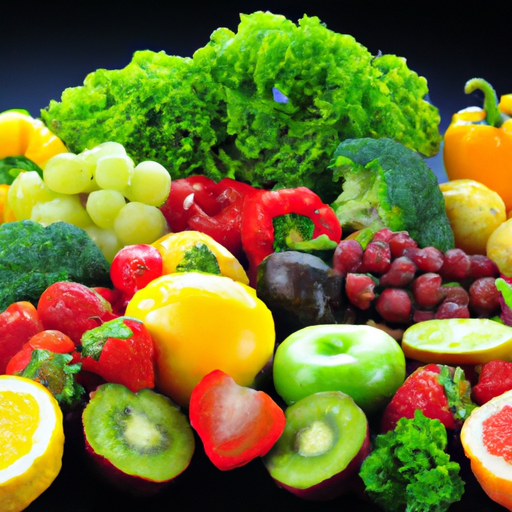Steps To Eat Healthy – Are you looking to make healthier choices when it comes to your diet? Look no further! In this article, you will discover simple steps to eat healthy without feeling overwhelmed. From incorporating more fruits and vegetables into your meals to choosing whole grains and lean proteins, these practical tips will help you on your journey to a healthier lifestyle. So, let’s get started on the path to nourishing your body and feeling great!
Steps To Eat Healthy
Planning your meals is an essential step in maintaining a healthy diet. By taking the time to create a weekly meal plan, you can ensure that you have nutritious and balanced meals throughout the week.
1.1 Create a Weekly Meal Plan
Start by setting aside some time each week to plan out your meals. Consider what ingredients you already have on hand and what meals you would like to prepare. This will help you avoid last-minute trips to the grocery store and reduce the temptation to order takeout or eat unhealthy convenience foods.
When creating your meal plan, aim for a balance of different food groups, including fruits, vegetables, whole grains, lean proteins, and healthy fats. Consider incorporating a variety of recipes and flavors to keep your meals interesting and enjoyable.
1.2 Include a Variety of Nutrient-Dense Foods
Incorporating a variety of nutrient-dense foods into your meal plan is key to ensuring that you are getting all the necessary vitamins, minerals, and antioxidants your body needs. Include a colorful array of fruits and vegetables in your meals to provide a wide range of nutrients. Opt for whole grains, such as brown rice, quinoa, and whole wheat bread, to increase your fiber intake and provide long-lasting energy.
Don’t forget about lean proteins like chicken, fish, tofu, and legumes, which are essential for muscle repair and growth. Lastly, be sure to include healthy fats from sources such as avocados, nuts, and olive oil, as they are important for brain function and heart health.
1.3 Consider Portion Sizes
While planning your meals, it’s important to consider portion sizes. Even when eating nutritious foods, consuming excessive portions can lead to weight gain and other health issues.
Aim for balanced portions that include a palm-sized serving of protein, a fist-sized portion of carbohydrates, and a generous serving of vegetables. Don’t forget to moderate your intake of high-calorie foods like nuts, seeds, and oils, as they can quickly add up in calories.
2. Make a Grocery List
Creating a grocery list is a crucial step in eating healthy. By planning your meals and making a list, you can avoid impulse purchases and ensure that you have all the necessary ingredients for nutritious meals.
2.1 Prioritize Whole Foods
When making your grocery list, prioritize whole foods. These are foods that are as close to their natural state as possible and undergo minimal processing. Whole foods are rich in nutrients and free from added sugars, unhealthy fats, and artificial additives. Examples of whole foods include fruits, vegetables, whole grains, lean proteins, and healthy fats like avocados and nuts.
By focusing on whole foods, you can ensure that your meals are packed with essential nutrients and minimize your intake of processed and unhealthy options.
2.2 Choose Fresh Fruits and Vegetables
When selecting fruits and vegetables, opt for fresh options whenever possible. Fresh produce is typically higher in nutrients and has better flavor compared to frozen or canned varieties. Visit local farmers’ markets or grocery stores that offer a wide selection of fresh produce.
Remember to incorporate a variety of colorful fruits and vegetables into your grocery list to ensure that you are getting a wide range of vitamins, minerals, and antioxidants.
2.3 Opt for Lean Proteins
Include lean proteins on your grocery list to ensure that you have a variety of options for your meals. Some healthy choices include skinless chicken breast, turkey, fish, tofu, beans, and lentils. These protein sources are lower in saturated fat and provide essential amino acids necessary for maintaining muscle mass and promoting overall health.
2.4 Select Healthy Fats
Don’t forget to include healthy fats on your grocery list. Healthy fats, such as avocados, nuts, seeds, and olive oil, are important for brain health, hormone production, and the absorption of fat-soluble vitamins. Incorporating these into your meals can also make them more satisfying and flavorful.
2.5 Avoid Processed Foods and Sugary Drinks
When making your grocery list, be mindful of avoiding processed foods and sugary drinks. These items are often high in added sugars, unhealthy fats, and artificial additives. Instead, opt for fresh, whole foods to provide your body with the nutrients it needs. If you’re craving a sweet drink, consider making your own fruit-infused water or herbal tea for a healthier option.

This image is property of images.unsplash.com.
3. Shop Mindfully
Once you have your grocery list in hand, it’s time to head to the store. Shopping mindfully can help you make healthier choices and stay on track with your meal plan.
3.1 Stick to Your Grocery List
While at the store, resist the temptation to stray from your grocery list. Stick to the items you have planned and avoid impulse purchases of unhealthy snacks or processed foods. By sticking to your list, you can ensure that you have the necessary ingredients for nutritious meals and avoid wasting money on unnecessary items.
3.2 Read Food Labels
When selecting products at the store, make it a habit to read food labels. Pay attention to the ingredients list and the nutritional information. Look for products with minimal added sugars, unhealthy fats, and artificial additives. Choose options with shorter ingredient lists and ingredients that you recognize.
3.3 Buy Seasonal and Local Produce
Whenever possible, choose seasonal and locally grown produce. Seasonal produce is usually fresher, more flavorful, and can often be found at a lower price. By buying local, you support your community’s farmers and reduce the environmental impact of transporting food over long distances.
4. Prepare Your Own Meals
Preparing your own meals allows you to have full control over the ingredients and cooking methods used. By cooking at home, you can ensure that your meals are healthy, flavorful, and tailored to your dietary needs.
4.1 Cook at Home Instead of Eating Out
While eating out can be convenient, it often involves consuming larger portions, unhealthy ingredients, and excessive amounts of added sugars and unhealthy fats. By cooking at home, you have the opportunity to choose healthier ingredients and cooking methods.
Commit to cooking at home more often and experiment with new recipes and flavors. Get creative and enjoy the process of preparing nutritious meals that nourish your body.
4.2 Choose Healthy Cooking Methods
When preparing your meals, choose cooking methods that preserve the nutrients in your ingredients. Opt for methods such as steaming, grilling, baking, or sautéing instead of deep-frying or using excessive amounts of oil. These methods will help retain the flavor and texture of your ingredients without adding unnecessary calories.
4.3 Experiment with Herbs and Spices for Flavor
One way to enhance the flavor of your meals without adding excess salt, sugar, or unhealthy fats is to experiment with herbs and spices. By incorporating a variety of herbs and spices into your cooking, you can add depth and complexity to your dishes. Try experimenting with flavors such as garlic, ginger, cilantro, cumin, and turmeric.
4.4 Pack Your Lunches
To help you stay on track with your healthy eating goals, consider preparing and packing your lunches in advance. This way, you can control the ingredients and portion sizes of your meals, even when you’re away from home. Plan your lunches as part of your weekly meal planning and take the time to pack them the night before or in the morning. This will help you avoid the temptation of unhealthy options when you’re pressed for time or hungry.

This image is property of images.unsplash.com.
5. Focus on Whole Foods
To maintain a healthy diet, it’s important to focus on consuming whole foods as much as possible. Whole foods are rich in nutrients and provide numerous health benefits.
5.1 Consume a Variety of Fruits and Vegetables
Including a wide variety of fruits and vegetables in your diet is crucial for optimal health. These colorful plant-based foods are packed with vitamins, minerals, and antioxidants that support your immune system, promote healthy digestion, and reduce the risk of chronic diseases. Aim for a colorful plate by including fruits and vegetables of different colors in your meals.
5.2 Include Whole Grains
Whole grains, such as brown rice, quinoa, oats, and whole wheat bread, provide essential nutrients and fiber. Unlike refined grains, which have been stripped of their bran and germ, whole grains retain these nutritious components. Incorporate whole grains into your meals to boost your fiber intake, support digestion, and provide long-lasting energy.
5.3 Incorporate Lean Proteins
Lean proteins are essential for building and repairing tissues, supporting immune function, and regulating hormones. Opt for lean protein sources such as chicken, turkey, fish, tofu, beans, and lentils. These options are lower in saturated fat and provide essential amino acids. Experiment with different cooking methods and flavors to keep your meals interesting.
5.4 Opt for Healthy Fats
Healthy fats are an important part of a balanced diet as they help support brain function, absorb fat-soluble vitamins, and promote healthy skin. Include sources of healthy fats such as avocados, nuts, seeds, and olive oil in your meals. These fats are rich in monounsaturated and polyunsaturated fatty acids, which can help reduce the risk of heart disease.
5.5 Stay Hydrated
Staying hydrated is crucial for overall health and well-being. Make it a priority to drink plenty of water throughout the day to maintain proper hydration. Water helps regulate body temperature, aids digestion, and transports nutrients to the cells. Carry a reusable water bottle with you to remind yourself to drink water regularly.
6. Control Portion Sizes
Controlling portion sizes is important to prevent overeating and maintain a healthy weight. By paying attention to your portions, you can still enjoy a wide variety of foods while staying on track with your health goals.
6.1 Use Smaller Plates or Bowls
One simple trick to help control portion sizes is to use smaller plates or bowls. Research suggests that using smaller dishware can trick your brain into perceiving larger portions, leading to feelings of satisfaction with less food.
6.2 Measure Your Food
If you’re unsure about portion sizes, consider measuring your food with measuring cups or a food scale. This can help provide a visual reference for appropriate serving sizes and prevent unintentional overeating.
6.3 Avoid Eating Straight from Packages
Eating straight from packages, such as bags of chips or boxes of cookies, can easily lead to mindless overeating. Instead, portion out your snacks onto a plate or into a bowl. This allows you to be more mindful of the quantity you’re consuming and avoid consuming excessive calories.
6.4 Eat Mindfully and Slowly
When enjoying your meals, take the time to savor each bite and be present in the moment. Eating mindfully involves paying attention to the flavors, textures, and smells of your food. By eating slowly, you can give your brain and body time to recognize feelings of fullness, preventing overeating.

This image is property of images.unsplash.com.
7. Limit Added Sugars and Processed Foods
Excessive consumption of added sugars and processed foods has been linked to various health problems, including weight gain, insulin resistance, and an increased risk of chronic diseases. It’s important to be mindful of your intake and make healthier choices.
7.1 Read Nutrition Labels for Hidden Sugars
When shopping for groceries, make it a habit to read nutrition labels and ingredient lists. Keep an eye out for hidden sources of added sugars, such as high-fructose corn syrup, cane sugar, and dextrose. These hidden sugars can be found in a variety of processed foods, including sweetened beverages, breakfast cereals, condiments, and baked goods.
7.2 Reduce Your Intake of Sugary Snacks and Beverages
One of the easiest ways to reduce your intake of added sugars is to limit your consumption of sugary snacks and beverages. Instead of reaching for a candy bar or soda, opt for healthier alternatives such as fresh fruit, unsweetened yogurt, or flavored water.
7.3 Minimize Processed Foods
Processed foods often contain large amounts of added sugars, unhealthy fats, and artificial additives. To improve your overall health, aim to minimize your consumption of processed foods. Instead, focus on whole, unprocessed foods that nourish your body with essential nutrients.
7.4 Be Aware of Artificial Sweeteners
While artificial sweeteners can provide a calorie-free alternative to sugar, their long-term effects on health are still debated. Some studies have suggested a possible link between artificial sweeteners and negative health outcomes. It’s best to consume these sugar substitutes in moderation and opt for natural sweeteners like honey or maple syrup when possible.
8. Stay Hydrated
Staying properly hydrated is essential for overall health and well-being. Water is involved in numerous bodily functions, including digestion, circulation, and temperature regulation. Make a conscious effort to drink sufficient water throughout the day.
8.1 Drink Sufficient Water
The Institute of Medicine recommends drinking about 2 liters (8 cups) of water per day for most adults. However, individual water needs may vary depending on factors such as activity level, climate, and overall health. Pay attention to your body’s signals of thirst and aim to drink water regularly throughout the day.
8.2 Limit Your Intake of Sugary Drinks
Sugary drinks, such as soda, fruit juices, and sweetened coffee or tea, can contribute to excessive calorie intake and weight gain. These drinks are often high in added sugars and provide little to no nutritional value. Whenever possible, choose water or unsweetened beverages as your go-to hydration option.
8.3 Try Infused Water or Herbal Tea
If you find plain water boring, try infusing it with slices of fresh fruit, herbs, or cucumber for a refreshing twist. Herbal tea is another great option to stay hydrated while enjoying different flavors and additional health benefits. Experiment with different combinations and discover your favorite infused water or herbal tea recipes.

9. Practice Mindful Eating
Mindful eating is a practice that involves paying attention to your body’s hunger and fullness cues, as well as being present in the moment and savoring your food. This approach can help you develop a healthier relationship with food and improve your overall eating habits.
9.1 Pay Attention to Hunger and Fullness Cues
Before eating, take a moment to assess your hunger level. Are you truly physically hungry, or are you eating out of habit or boredom? Likewise, pay attention to your body’s signals of fullness and satisfaction while eating. Eating slowly and mindfully can help you better recognize these cues and avoid overeating.
9.2 Eat Without Distractions
When eating, try to minimize distractions and focus on your meal. Turn off the TV, put away your phone, and create a calm environment. This will allow you to be more present during your meal and fully enjoy your food.
9.3 Chew Your Food Thoroughly
Chewing your food thoroughly not only aids digestion but also allows you to better savor the flavors and textures of your meal. Take your time with each bite, chew slowly, and enjoy the taste and texture of your food.
9.4 Savor the Flavors
Eating mindfully also involves savoring the flavors of your food. Take notice of the different tastes, aromas, and textures as you eat. By truly experiencing the flavors, you may find yourself feeling more satisfied and fulfilled by your meal.
10. Seek Professional Advice
If you have specific dietary needs or concerns, it may be beneficial to seek professional advice from a registered dietitian. Here are a few reasons why consulting with a dietitian can be helpful:
10.1 Consult with a Registered Dietitian
Registered dietitians are nutrition experts who can provide personalized guidance and advice based on your unique needs and goals. They can help you create a tailored meal plan, address food allergies or intolerances, and provide support for weight management, chronic diseases, and other health conditions.
10.2 Get Personalized Nutrition Recommendations
A registered dietitian can assess your current dietary habits, health status, and goals to provide personalized nutrition recommendations. They will take into account your preferences, lifestyle, and any dietary restrictions you may have. This personalized approach can help you develop a sustainable and enjoyable way of eating that supports your overall well-being.
10.3 Address Specific Dietary Needs or Concerns
If you have specific dietary needs, such as vegetarianism or food allergies, a registered dietitian can offer guidance and support in achieving a balanced and nutritious diet. They can help you identify alternative sources of nutrients, plan meals that meet your specific requirements, and ensure that you’re obtaining all the necessary nutrients.
In conclusion, eating healthy is a journey that starts with proper planning and preparation. By creating a weekly meal plan, making a grocery list, shopping mindfully, and preparing your own meals, you set yourself up for success. Focus on consuming whole foods, controlling portion sizes, and limiting added sugars and processed foods. Stay hydrated, practice mindful eating, and don’t hesitate to seek professional advice when needed. With these principles in mind, you can enjoy a balanced and nourishing diet that supports your overall health and well-being.


Leave a Reply